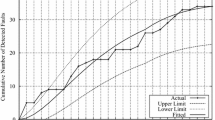Abstract
The duration of a software project is a very important feature, closely related to its cost. Various methods and models have been proposed in order to predict not only the cost of a software project but also its duration. Since duration is essentially the random length of a time interval from a starting to a terminating event, in this paper we present a framework of statistical tools, appropriate for studying and modeling the distribution of the duration. The idea for our approach comes from the parallelism of duration to the life of an entity which is frequently studied in biostatistics by a certain statistical methodology known as survival analysis. This type of analysis offers great flexibility in modeling the duration and in computing various statistics useful for inference and estimation. As in any other statistical methodology, the approach is based on datasets of measurements on projects. However, one of the most important advantages is that we can use in our data information not only from completed projects, but also from ongoing projects. In this paper we present the general principles of the methodology for a comprehensive duration analysis and we also illustrate it with applications to known data sets. The analysis showed that duration is affected by various factors such as customer participation, use of tools, software logical complexity, user requirements volatility and staff tool skills.


























Similar content being viewed by others
References
Angelis L, Sentas P (2005) Duration analysis of software projects. Proceedings of the 10th Panhellenic Conference on Informatics, pp 258–269
Angelis L, Stamelos I, Morisio M (2001) Building a software cost estimation model based on categorical data. Proceedings of the 7th IEEE International Software Metrics Symposium, pp 4–15
Ayal M (2004) The effect of scope changes on project duration extensions. PhD Dissertation, Faculty of Management, Tel Aviv University
Barry EJ, Mukhopadhyay T, Slaughter SA (2002) Software project duration and effort: an empirical study. Information Technology and Management 3(1–2):113–136
Boehm BW (1981) Software engineering economics. Prentice-Hall, Upper Saddle River, NJ
Boehm B (2000) Project termination doesn’t equal project failure. Computer 33(9):94–96
Boehm BW, Horowitz E, Madachy R, Reifer D (2000) Software cost estimation with COCOMO II. Prentice-Hall, Englewood Cliffs, NJ
Clark B, Chulani S, Boehm B (1998) Calibrating the COCOMO II post-architecture model. Proceedings of the 20th International Conference on Software Engineering, pp 477–480
Collet D (1994) Modelling survival data in medical research. Chapman & Hall, London
Hosmer DW, Lemeshow S (1999) Regression modelling of time to event data. Wiley, New York
ISBSG Data Disk (2005) Release 7 (http://www.isbsg.org.au)
Jain G (2002) Reducing the software project duration using global software development. Master thesis. Dept of Computer Science and Engineering, Indian Institute of Technology, Kanpur
Kaplan EL, Meier P (1958) Nonparametric estimation for incomplete observations. J Am Stat Assoc 53:457–481
Kitchenham B (1998) A procedure for analysing unbalanced datasets. IEEE Trans Softw Eng 24:278–301
Lee ET, Wang JW (2003) Statistical methods for survival data analysis, 3rd edn. Wiley, New York
Lind MR, Sulek JM (2000) A methodology for forecasting knowledge work projects. Comput Oper Res 27:1153–1169
Koru AG, Zhang D, Liu H (2007) Effect of coupling on defect proneness in evolutionary open-source software development. Proceedings of the IFIP 3rd International Conference on Open Source Systems (OSS) 2007, Springer, 271–276
Maxwell K (2002) Applied statistics for software managers. Prentice-Hall, Upper Saddle River, NJ
Maxwell K, Briand L, Emam K, Surmann D, Wieczorek I (2000) An assessment and comparison of common software cost estimation modelling techniques. Proceedings of the 22nd International Conference on Software Engineering, ICSE, 377–386
Mizuno O, Adachi T, Kikuno T, Takagi Y (2001) On prediction of cost and duration for risky software projects based on risk questionnaire. Proceedings of the Second Asia-Pacific Conference on Quality Software, pp 120–128
Oligny S, Bourque P, Abran A, Fournier B (2000) Exploring the relation between effort and duration in software engineering projects. Proceedings of the World Computer Congress, pp 175–178
Parmar MKB, Machin D (1995) Survival analysis. A practical approach. Wiley, Chichester
Putnam LH, Myers W (2003) Five core metrics: the intelligence behind successful software management. Dorset House, New York
Rainer A, Hall T (2003) A quantitative and qualitative analysis of factors affecting software processes. J Syst Softw 66(1):7–21
Rainer A, Hall T (2004) Identifying the causes of poor progress in software projects. Proceedings of the 10th International Symposium on Software Metrics, pp 184–195
Rainer A, Shepperd MJ (1999) Re-planning for a successful project schedule. Proceedings of the 5th IEEE International Software Metrics Symposium, pp 72–81
Sentas P, Angelis L (2005) Survival analysis for the duration of software projects. Proceedings of the 11th IEEE International Software Metrics Symposium
Shepperd MJ, Schofield C (1997) Estimating software project effort using analogies. IEEE Trans Softw Eng 23:736–743
Venables WN, Ripley BD (2002) Modern applied statistics with S. Springer, New York
Acknowledgement
The authors wish to thank the editor and the anonymous reviewers for their comments which helped in improving the paper.
Author information
Authors and Affiliations
Corresponding author
Additional information
Editor: Ross Jeffery
Rights and permissions
About this article
Cite this article
Sentas, P., Angelis, L. & Stamelos, I. A statistical framework for analyzing the duration of software projects. Empir Software Eng 13, 147–184 (2008). https://doi.org/10.1007/s10664-007-9051-7
Received:
Accepted:
Published:
Issue Date:
DOI: https://doi.org/10.1007/s10664-007-9051-7




